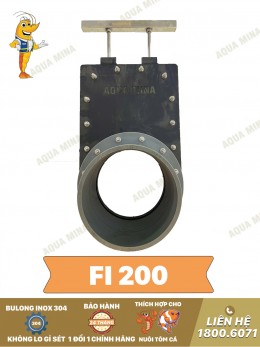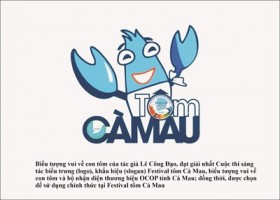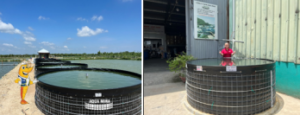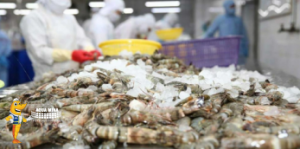Shrimp Farming Billionaire from Nghe An: The Key to Success for Vietnam's Outstanding Farmer of 2024

Nguyen Cuong: Vietnam's Outstanding Farmer of 2024
Challenges and Perseverance
I met Mr. Nguyen Cuong (born 1970), the owner of a shrimp farming model with an annual income of 25 billion VND, and the only representative from Nghệ An honored as the Outstanding Vietnamese Farmer of 2024. He was inspecting each shrimp pond with his workers, securing the tarps that had been dislodged under the extreme heat of mid-August.
It became clear that behind the brief achievements reported to the “Outstanding Vietnamese Farmer 2024” committee—“Annual income of 25 billion VND, creating jobs for dozens of local workers”—Mr. Cuong’s success came from over 20 years of hard work with sea shrimp. There were times when it seemed like he might lose everything and end up with nothing.
Mr. Cuong recounts that in 2002, while he was successfully running a reputable construction business in Diễn Châu with a desirable income, he became determined to venture into shrimp farming. He invested his capital to transform the barren coastal sands into ponds and reservoirs for shrimp cultivation.
Despite being a high-tech shrimp farming tycoon, Mr. Cuong remains hands-on, diligently overseeing his shrimp ponds and constantly learning and innovating to ensure sustainable shrimp farming.

Initially, he started shrimp farming with traditional extensive methods, but due to the significant impact of weather conditions, the productivity was low and profits were meager. He then gradually transitioned to intensive farming of white-leg shrimp. However, this too proved challenging. In the beginning, using traditional methods with unreliable water sources led to high shrimp mortality rates, resulting in financial losses and wasted effort. Mr. Cuong recalls that in 2016, a disease outbreak hit his 1-hectare shrimp pond, where shrimp had reached a weight of 50 shrimp per kilogram. The disease caused mass die-offs, forcing him to hire labor to remove and dispose of the dead shrimp and treat the ponds. That year's shrimp harvest left him empty-handed.
Embracing the philosophy of 'fall where you may, rise again from there,' Mr. Cuong continued to borrow and invest in shrimp farming. His persistence paid off with successful harvests, generating substantial profits. However, just a few years later, in 2021, the COVID-19 pandemic caused the market to freeze, with shrimp prices plummeting and sales grinding to a halt, leading to significant financial losses for him
Mr. Cuong's high-tech shrimp farming model
After each failure, I reflect on everything—from choosing the right breed to selecting feed and, most importantly, refining the farming process. After every shrimp farming cycle, my family spends an entire month drying out the ponds, treating disease pathogens, and waiting for clean seawater before refilling the ponds. As a result, we can only manage two cycles per year. Despite significant investments and meticulous care, profits are not high, and disease outbreaks can wipe us out. This constant struggle keeps me awake at night, Mr. Nguyen Cuong shared.

The Key to Success
After learning from successful white-leg shrimp farming models across the country and participating in scientific and technical training workshops, Mr. Cuong decided in 2022 to invest all his accumulated capital from 20 years of shrimp farming to upgrade his operations. He shifted from traditional pond-based farming to high-tech white-leg shrimp farming.
He boldly converted over 1.7 hectares to build two nursery tanks, each with an area of 200 m², and nine grow-out ponds, each over 1,000 m². The setup also included a system for holding, settling, and discharging waste to support a multi-phase, high-tech intensive farming process. Additionally, he constructed a fully equipped closed facility applying bio-secure shrimp farming technology.

Mr. Cuong inspects the shrimp larvae he raised himself
When I applied high-tech methods to a closed-system, three-phase shrimp pond with automatic climate control, I was able to farm four cycles per year. This intensive, staggered farming approach ensures that there are always shrimp available for sale, avoiding the oversupply and price drop issues I faced before. Additionally, high-tech farming requires less manual care, reduces the need for antibiotics, and ensures better disease safety, Mr. Cuong explained.
Mr. Cuong tested his method with 1.2 million juvenile shrimp. In Phase 1, the shrimp were reared in nursery tanks at a density of up to 4,000 shrimp/m² for 30 days. They were then transferred to Phase 2, where they were grown in ponds at a density of 600 shrimp/m² for one month. Finally, they moved to Phase 3 ponds until harvest. In a short time, he achieved a successful first harvest, yielding 14 tons of marketable shrimp with an average size of 70 shrimp/kg and earning nearly 900 million VND in profit.

Mr. Cuong's high-tech shrimp farming model has introduced a new direction, transforming the mindset and methods of shrimp farming among local farmers.
Building on that success, Mr. Cuong has expanded his operation to 20 shrimp ponds, including 6 with high-tech closed systems, 2 for breeding, and 3 for waste treatment. His annual production reaches 150 tons of marketable shrimp, providing steady employment for 10 local workers, with monthly earnings of 8-10 million VND per person.
Business is Stronger with Community Support
Applying new technology to the super-intensive shrimp farming process has brought several clear benefits: it has made pond management and care easier, reduced the risk of disease, lowered production costs, increased productivity and economic efficiency, and protected the pond environment, leading to higher profits.
Mr. Cuong provides stable employment and income for many local workers.

Recognizing the benefits of investing in high-intensity whiteleg shrimp farming, Mr. Cuong has encouraged local farmers to gradually adopt this model. Throughout this process, he has been eager to share his expertise, providing detailed guidance and hands-on support to each farm.
In addition to shrimp farming, Mr. Cuong's family runs a business in aquaculture feed and supplies, offering support to local shrimp farmers. When farmers face financial difficulties, he is ready to help by providing shrimp larvae, selling feed on credit with low interest, and allowing payment upon harvest. Mr. Cuong plans to establish a cooperative to bring together local aquaculture farmers.
Farming shrimp in staged phases has proven to be highly effective for intensive shrimp cultivation.
“Plans for the cooperative include 30 members from local aquaculture families. The cooperative will serve as a platform for sharing experiences and supporting each other through tough times. Members will benefit from collective purchasing of supplies and equipment at discounted rates, reducing production costs. Importantly, the cooperative will enable members to manage inputs and explore market connections, thereby increasing their incomes and promoting sustainable shrimp farming,” Mr. Cuong explained.
Source: Thanh Phuc (Nghe An Newspaper)
Ngày đăng : 14/09/2024
2681 View
Other Articles
Vietnamese shrimp and catfish choose a sustainable path in global competition
End-of-Season Shrimp Prices Reach Record Highs
Norway – Russia Reach Barents Sea Fisheries Agreement for 2026
Cà Mau strengthens traceability to enhance the competitiveness of the shrimp industry.
Cold stress: Effects on the plasma characteristics of whiteleg shrimp.
A new breakthrough in the prevention of diseases caused by the microsporidian parasite EHP in shrimp farming
Vietnam’s shrimp export outlook in the first quarter of 2026 continues to face heavy pressure from tariffs.
New England’s shrimp fishery to shut down for the long haul after years of decline
Crab exports to the United States account for more than 80%.
Thailand sets a target to increase shrimp production to 400,000 tons by 2026.
CTU-RAS: Recirculating Shrimp Farming for Sustainable Development
Vietnamese aquatic products reach new markets



















.jpg)